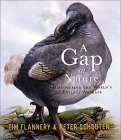A Gap in Nature: Discovering the World's Extinct Animals by Stephen F. Flannery and Peter Schouten
Lighthouse keeper David Lyall was lonely, so he brought a cat to live with him. Lyall's post, Stephen's Island, lay in the Cook Strait, the oceanic fracture that splits New Zealand. Many species of flightless bird -- moas, kakapos, kiwis -- lived on the islands before the the successive invasions of the Maori and the British. Hunting by humans and their pets exterminated all but a few of these.
Stephens Island was the last stand of a relic of the days before the humans brought their dogs, their pigs, and rats to the island,  a tiny flightless bird that scampered about "like mice" on the remote rock. Lyall's cat enjoyed the sport of hunting them. Every few days, it would bring one of the avians home to Daddy, who sent seventeen of the less ravaged carcasses to distant museums. After a year of its predation, this cat single-handedly pushed the Stephen's Island wren into extinction. No other feline has served in the exclusive capacity as death angel for a whole species.
a tiny flightless bird that scampered about "like mice" on the remote rock. Lyall's cat enjoyed the sport of hunting them. Every few days, it would bring one of the avians home to Daddy, who sent seventeen of the less ravaged carcasses to distant museums. After a year of its predation, this cat single-handedly pushed the Stephen's Island wren into extinction. No other feline has served in the exclusive capacity as death angel for a whole species.
Flannery and Scouten have written a marvellous, tear-provoking coffee table book. Schouten's pictures recreate the living semblances of some 103 creatures of land, sea, and air, many of which are known only from skeletons, skins, or pickled cadavers. Flannery's accompanying text tells the stories of egg plunder, habitat destruction, over-hunting, and species invasion that killed off the Dodo, the Stellar's Sea Cow, the Great Auk, the Labrador Duck, the Thyalacine, and many other creatures we will never see again. "[T]his has been one of the most exciting projects I have ever been involved in," Flannery writes in the preface, "because it has allowed me to capture....a tiny flicker of the wonder of the lost world."
Not so long ago, I paid a visit to the San Diego Wild Animal Park where three of the last northern white rhinos spend their last days. Visitors stood up in the tram to get a glimpse of the distant beasts. In a few years, all we will have of these are photos, bones, skins, and tissue samples. A Gap in Nature does achieve Flannery and Schouten's aim of making us think about the legacy of biological diversity that our rapacious ways have cost us. Will books like this save what is left? Alas. The northern white rhino appears to be doomed nonetheless.
Posted by EmperorNorton at July 12, 2002 09:56 PM | TrackBack